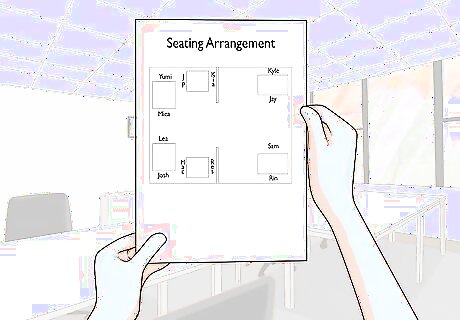
views
Avoiding Cliques as an Employee

Spot a bad clique by looking for exclusivity. Small groups of people that hang out together aren’t always bad, but if your coworkers make fun of others, gossip about people, or hang out together without including anyone else, they probably aren’t creating a great environment. Keep an eye out for these cliques in your workplace.

Keep your distance from cliques. If you can avoid it, don’t join a clique in your workplace. This can be tough if you work closely with a small group of people, but you can keep your distance by remaining friendly without becoming exclusive friends with them. When cliques form, the reputation of the clique precedes the reputation of individual people. When new people hear about you, they’ll be hearing about the actions of the clique, not you as a person.

Mingle with a variety of people during work hours. If you like different people from different cliques, invite those individuals to get lunch or coffee with you. Try to diversify your friendships and don’t talk to people that are all in one clique. If you are asked to hang out with a clique, it’s fine to accept. Just be open to hanging out with other people as well so you don’t keep your friendships exclusive.

Prioritize your job performance over socializing with coworkers. Try not to be intimidated by the cliques. If the members of a certain clique don’t like you, it can feel scary and slightly threatening to go to work. Focus on doing your job well and try not to pay attention to those who may not like you.

Avoid gossiping about other members of the office. Find other things to talk about with your coworkers besides people who you work with, like current events, sports, or pop culture. If you have a complaint or problem with someone in the office, try talking to them about it directly instead of other people. Think about how you’d feel if you found out your coworkers were talking badly about you.

Maintain your personal friendships outside of work. Although workplace connections are important, try to hang out with your friends that you don’t work with, too. This will help you rely less on your coworkers for friendship.Tip: If you don’t have many friends outside the workplace, try joining a local sports team or a club to get to know people with similar interests as you.

Seek guidance from a manager or mentor if you need to. If the cliques at your work are getting too difficult to deal with, try asking someone in your field for advice, like a manager or an older coworker. Try to avoid mentioning specific names so you don’t seem like you are telling on your coworkers. Say something like, “You’ve been in this field a long time and I was wondering if you’ve ever had to deal with cliques before. Do you have any advice for me?”

Find another workplace if your job becomes hostile. If the cliques at your workplace are starting to gang up on you or it’s becoming difficult to do your job, consider looking for another place to work with stricter management or a different work style. Although it may be hard to tell where the cliques are before you start working somewhere, you can ask your potential employer about the workplace environment to get a feel for it before you start. Ask something like, “At my old job, people took their friendships pretty seriously, and it started to affect their work. What are the coworker relations like around here?”
Managing Cliques in Your Workplace

Tell your employees that you expect them to be inclusive. Lead your employees by example and tell them that you expect everyone to feel included and welcomed in their workplace. Make it clear that if you see anyone being excluded on purpose, there will be consequences. Make sure you are also being inclusive so that your employees follow in your footsteps.

Listen to your employee’s comments. Ask to meet with people one on one and listen to their side of the story. If they are the ones being excluded, ask them how they think they could feel more included. If they are the ones forming cliques, ask them why they thought it was necessary to form separate groups within the workplace. Try not to accuse anyone of anything in these meetings. Instead, be open and take everything that is said into consideration.

Rotate your employees’ seating arrangement every week. If you can, try having your employees sit next to new people at least once a week to diversify who they talk to and make connections with. This will allow them to build work relationships with people they may not have had a chance to talk to before. If your office doesn’t have an open floor plan, this can be tricky. However, you can hold meetings where everyone sits next to someone who isn’t in their department for a small diversification.

Bring your employees together for a common cause. Take a look at the core values of your company for some ideas of a common cause. For example, if your workplace values giving back to the community, arrange a day for you and your employees to volunteer at a food bank. Reaching a common goal makes people feel more connected.

Show appreciation for each and every one of your employees. Often, the only people who are praised are the superstar employees who make the most money or go above and beyond their quota. Try to pay attention to those who have been steadily working hard for a long time and may have faded into the background. Single those employees out and praise them for their hard work as well. Feeling appreciated makes employees value their job more and may even make them work harder.

Create opportunities for inclusion. Organize lunches or an after-hours event that everyone is invited to. Don’t make it mandatory, but make sure your employees know that all are welcome, not just the people in cliques. Try creating these opportunities once a month so people can arrange their schedules around them.Tip: Even if an employee declines the offer to go out, keep inviting them. They may not feel welcomed enough to join in yet.




















Comments
0 comment